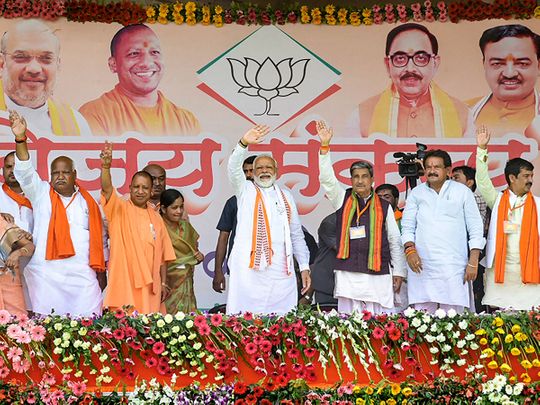
Before there is an assessment of the ground situation for the upcoming assembly elections in India’s biggest state — Uttar Pradesh (UP), let’s not forget it was this state that made Narendra Modi the Prime Minister of the country.
With a massive sweep (Bharatiya Janata Party won 71 of 80 parliamentary seats) and 42% vote share, UP was central to BJP’s ascend to power. More so because Modi chose Varanasi, India’s ancient and holy city, in Eastern UP, to represent in India’s parliament.
The selection of Varanasi, the most revered Hindu pilgrimage town, was a well-thought out decision that had a huge relevance for Modi’s personal and political journey.
Gujarat is Modi’s past, UP is his present
Winning two Lok Sabha elections and one assembly election (312 out of 403 seats and 39.67% vote share) were no mean achievements. These victories went on to become the fundamental bloc of Modi’s political edifice against the massive secular opposition against him.
Political pundits in Delhi who continue to brand Modi primarily as a ‘Gujarati’ are missing the wood for the trees. The fact remains that Modi’s rise in Delhi was possible only because of his mass acceptance among the UP voters.
Amit Shah, who has been justifiably credited for weaving UP’s caste cauldron and strategising booth level management in Lok Sabha elections (2014, 2019) and assembly election (2017) too, has spent hundreds of hours and has clocked countless thousands of miles within the state between 2012 to 2017. That effort made Modi’s stunning rise possible.
Rise of Adityanath
A few decision have been as symbolic and stunning as the nomination of a Hindu seer, Yogi Adityanath, in one of the most powerful political seats in the Indian political administration. This took place at a time when not a single minority leader was elected to the parliament from UP.
The saffron-clad leader was given the power to head the most difficult state to ensure that overarching umbrella of the UP administration will be based on politics veering around the Hindu identity.
Obviously, being a Hindu seer, Yogi symbolised all things Hindu. He hardly needed to speak for the Hindus. His appearance on the political platform would say it all.
After establishing a permanent ‘saffron’ presence in Lucknow, Modi and Shah wanted to change the basic matrix of UP politics. That is to diffuse the caste dominance, bridge the gap of hundreds of upper, intermediary and lower castes within the society and build a strong Hindu identity to connect seamlessly the divided regions of the Western UP, Awadh, Purvanchal and Bundelkhand.
However the politics of the UP is not so easy. Not even the authority held by Modi and Shah can navigate its complex realities without multiple checkmates.
In Lucknow one often hears that Yogi Adityanath runs his administration in a ‘my way or the high way’ style. Within the cabinet, Yogi doesn’t have too many friends. He has been accused of promoting his caste-base of Thakurs.
This has upset the Brahmins, the party’s biggest supporters. On the sociopolitical matrix, not much has changed since 2017. Most of the BJP’s Members of the Legislative Assembly (MLAs) and Members of Parliament (MPs) are known more by their respective caste identities and less by the nationalistic fervour that the BJP would like to spread.
Stock taking time for Modi
As preparations for the UP assembly election begin, it’s stocktaking time for Modi-Shah. The question is whether their hard Hindutva gamble — of promoting Yogi — has paid off?
Yogi’s presence hasn’t eclipsed a bit the caste-based power struggles. He has copied Modi’s style of building his own image and is engaged in a high-cost public relation exercise through friendly media.
Yogi doesn’t want to leave the levers of power. But, Modi can’t put all eggs in Yogi’s basket because the UP voters can make or break the BJP.
In Delhi and Lucknow, both the governments have seriously weighed the pros and cons of carving out of Purvanchal, which will include Varanasi, out of unwieldy state of UP. By doing so, Varanasi, Modi’s political base would be more secure. It will also be advantage BJP. The decision has not been taken but the options remain on the table.
While taking a long-term view to control UP’s political unit, Modi has moved his favourite bureaucrat (belonging to the same region as Yogi) to Lucknow. A.K. Sharma, introvert but politically sharp, has taken early retirement from the service and joined the BJP. He has been Modi’s confidant since 2001.
Made the Vice President of the state BJP, this is to ensure a direct control of the state — in the run up to the election — from the PMO.
Yogi, on his part, has pursued Hindutva politics but with mixed results. So in the end Modi has ended up with a leader in Yogi who wants to chart his own course.
In the coming elections, which is considered the semi-final for the Lok Sabha elections of 2024, UP is back to where it was before Yogi took over.
The BJP has a few options other than going into these elections with the twin plank of caste politics and Hindutva.








